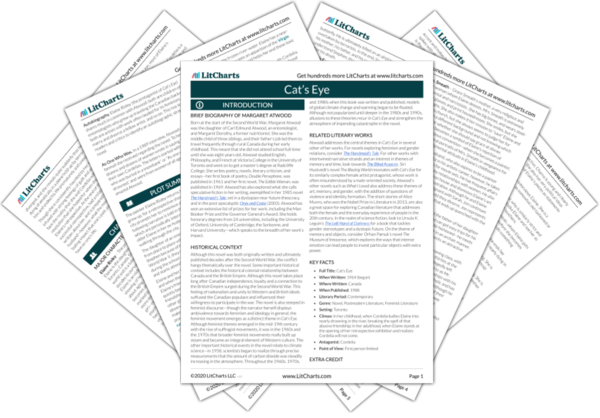Elaine learns about the Virgin Mary when she starts going to church with the Smeaths. Although she ends up growing distant from organized religion, visions of Mary recur throughout her life; Mary emerges as a force of maternal protection and hope, who stands in contrast to the neglectful figures in Elaine’s life. Mary takes on many names in the novel: “The Virgin, Our Lady of Perpetual Help, The Virgin of Lost Things.” When she starts getting bullied by Cordelia, Carol, and Grace, Elaine decides “to do something dangerous, rebellious, perhaps even blasphemous”: to pray to the Virgin Mary instead of to God. For Elaine, Mary represents a kind of freedom or hope that she does not find in the Christian God. She paints the Virgin Mary as a lioness later, and describes her as “fierce, alert to danger wild” with a “gnawed bone” at her feet. This wildness and fierce protectiveness defines her image of Mary. By contrast, her parents, even her own mother, disregard the bad things that happen to her, as does God.
When Elaine nearly freezes in the ravine after Cordelia throws her hat down, Elaine notably sees a vision of the Virgin Mary. She says she feels “her around me, not like arms but like a small wind of warmer air.” Mary says to her, “You can go home now.” At the end of the novel, she admits that this was only a fantasy, and that “nobody came.” This suggests that Mary represents Elaine’s fierce desire to be seen and protected. She is a symbol of maternal intervention, the voice of intercession that Elaine has so sorely lacked. For Elaine, she is “wrapping me in warmth and painlessness, she has heard me after all.” The core of the bullying that Elaine faces consists of her friends overly-scrutinizing her and judging her behavior; this fantasy of Mary represents the desire to just be seen and supported.
The particular iterations of Mary that recur to Elaine are the “Lady of Perpetual Help” and the “Virgin of Lost Things.” She sees the later on an altar in Mexico when she visits with her husband Ben, and examines the tin symbols of items that other people lost and pinned to her. In her own later painting, she depicts a Lady of Perpetual Help descending to earth with “two brown paper bags of groceries.” In this painting, “she looks tired.” These versions of Mary represent the domestic role of women, who humble themselves in service to others. This suggests Elaine's view that helping others, particularly in the manner expected of women, requires a certain sacrifice of self.
Virgin Mary Quotes in Cat’s Eye
I hear someone talking to me. […] The person who was standing on the
bridge is moving through the railing, or melting into it. It’s a
woman […] She isn’t falling, she’s coming down toward me as if walking, but
there’s nothing for her to walk on. […] Now she’s quite close. I can see the white glimmer of her face, the dark scarf or hood around her head, or is it hair? She holds out her arms to me and I feel a surge of happiness. Inside
her half-open cloak there’s a glimpse of red. It’s her heart, I
think. It must be her heart, on the outside of her body, glowing
like neon, like a coal. […] You can go home now, she says. It will be all right. […] I don’t hear the words out loud, but this is what she says.










